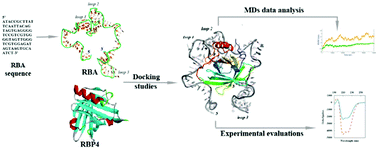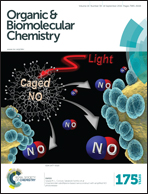An investigation on the interaction modes of a single-strand DNA aptamer and RBP4 protein: a molecular dynamic simulations approach†
Abstract
Type two diabetes is one of the primary health issues threatening public well-being worldwide. One of the pre-diagnosis biomarkers of this disease, retinol binding protein 4 (RBP4), has been demonstrated to be detected with a 76-mer ssDNA aptamer instead of conventional antibodies. However, there is no structural information on the RBP4 binding aptamer (RBA) and the mechanism of its binding to RBP4 still remains unexplored. The objective of the present study is to achieve a better understanding of specific binding interactions of the target protein (RBP4) and RBA, employing Molecular Dynamics simulations (MDs) to provide detailed information on fluctuations, conformational changes, critical bases and effective forces to develop regulated aptamers to be employed in designing new aptamers for many useful recognition applications. RBA was designed according to its reported base pair sequence and secondary structure. The HADDOCK on line docking program was used to predict a suitable RBP4–RBA mode of interaction to start MDs with. MDs methodology was used to analyze the final complex stability and detect interacting residues. Eventually, we conclude that single strand located bases are the key components that conduct the intercalation phenomenon with big targets rather than those involving loops and folded motifs, to encompass targets and probably inhibit their activity. Also, UV–visible, circular dichroism and fluorescence spectroscopy measurements confirmed the interactions between RBA and RBP4 and RBP4–RBA complex formation.


 Please wait while we load your content...
Please wait while we load your content...